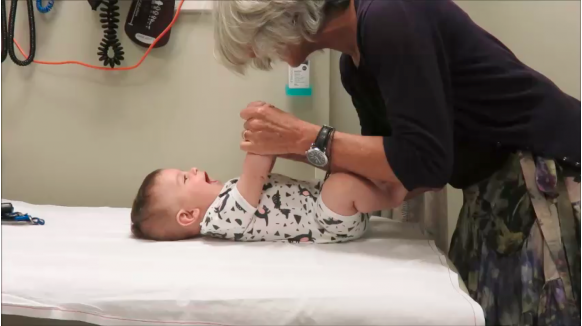Helping babies avoid getting a flat head

Babies who acquire a flat spot on their skull tend to have less developed head control, according to new research from the University of Melbourne.
Physiotherapist Liz Williams has created a fact sheet for new parents to help them avoid what she said could and should be an avoidable condition: plagiocephaly, or flat-headedness.
Mrs Williams said current advice for parents to give babies plenty of “tummy time” and alternate on which side their head rests does not go far enough.
“Many new parents follow advice to ‘position’ their resting baby with their head on one side, then on the other side, when we need to encourage babies to be active, to move themselves by engaging with them from birth,” said Mrs Williams, who is also a PhD candidate.
Plagiocephaly is caused by prolonged pressure on the baby’s growing skull, flattening the back of the head and, in severe cases, causing distorted facial features and a bulging forehead. Some babies wear special head shape-correcting helmets to remedy the problem.
Plagiocephaly has become relatively common since 1992, when the “back to sleep” message was widely adopted to combat Sudden Infant Death Syndrome. In Australia, Red Nose recommends sleeping babies on their back, and Mrs Williams fully supports that vital life-saving message.
A Canadian study found almost of half of 440 healthy two to three-month-olds had plagiocephaly, with 10 per cent so severe they needed treatment.
The Royal Children’s Hospital’s plagiocephaly clinic, which treats about 1330 babies a year, worked with Mrs Williams to determine which babies develop the condition.
The research found that babies at the plagiocephaly clinic are an average of seven months old yet over half (54 per cent) did not meet pull-to-sit development guidelines for head control.
“It is reasonable to expect infants to control their heads, especially to the midline and side to side with a ‘chin tuck’, by two to three months and to maintain their head against gravity by themselves when pulled up to a sitting position by four to five months,” Mrs Williams said.
Improved head control would enable babies to not get stuck on one side, reducing that prolonged pressure on one spot. Mrs Williams hopes a fact sheet she created with the Royal Children’s Hospital will help reduce the number of babies being treated for plagiocephaly and empower parents to encourage their babies to gain better head control.
The resource advises:
- Sleep baby on their back from birth, not on their tummy or side
- Even newborn babies can move their head to each side by following their parents’ eyes or voice
- From birth babies need both tummy time and face time, which can be on the floor
- Babies heads are heavy and need support
- Tummy time can include when your baby is lying on you
More on Pursuit.